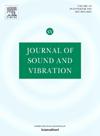基于声场边界条件可控的双板结构声传播主动控制
IF 4.3
2区 工程技术
Q1 ACOUSTICS
引用次数: 0
摘要
双面板结构在交通运输车辆、航空航天、航空结构等方面有着广泛的重要应用。为了提高双面板结构的低频隔声性能,提出了一种基于声场边界条件可控的主动控制策略来提高双面板结构的低频隔声性能。利用双层结构的层间空间,将矩形简支板作为新的可控边界嵌入层间声场边界,称为可控边界板(controlled boundary plates, CBPs)。控制力量是在海关和边境保护局实施的。采用封闭声场总时间平均声势能(TAPE-E)最小、层间声场总时间平均声势能(TAPE-I)最小、底板平均动能(AKE-L)最小三个控制目标来优化控制力。结果表明,CBP的布置可以显著改变整个系统的振声耦合性能。采用三种不同控制目标函数的主动控制策略,可以实现双面板隔声性能的理想改善。与点声源相比,CBP可以看作是多个单极子和偶极子的组合,在高频范围内可以获得更好的控制性能。此外,还研究了控制力的尺寸、数量和位置对控制效果的影响。通过计算分析,主要有两种控制机制,即模态抑制和模态重排。该研究为工程结构主动噪声控制和提高低频隔声性能提供了指导。本文章由计算机程序翻译,如有差异,请以英文原文为准。
Active control of sound transmission through double-panel structure into an enclosure based on controllable boundary condition of sound field
Double-panel structure has a wide range of important applications in transportation vehicles, aerospace, and aeronautical structures and so on. To improve the low frequency sound insulation performance of the double-panel structure, an active control strategy based on controllable boundary condition of sound field is proposed to improve the low frequency sound insulation performance of double-panel structure. Taking advantage of the interlayer space of double-panel structure, the simply supported rectangular plates are embedded into the boundaries of the interlayer sound field as new controllable boundaries, which is named controlled boundary plates (CBPs). The control force is applied at the CBP. Three control objectives, i.e., minimization of total time averaged acoustical potential energy of enclosure sound field (TAPE-E), minimization of total time averaged acoustical potential energy of interlayer sound field (TAPE-I), and minimization of averaged kinetic energy of the low panel (AKE-L), are adopted to optimize the control forces. The results indicate that the arrangement of CBP can significantly alter the vibro-acoustic coupling performance of the overall system. The active control strategy with the three different control objective functions can achieve ideal improvement of sound insulation performance of double-panel. In comparison with point acoustic source, the CBP can be regarded as a combination of multiple monopoles and dipoles, the better control performance can be obtained in high frequency range. In addition, the effects of the dimension, number and location of control force are investigated. Through calculation and analysis, there are two main control mechanisms, i.e., modal suppression and modal rearrangement. This study provides guidelines for the active noise control and the improvement of the low frequency sound insulation performance of the engineering structures.
求助全文
通过发布文献求助,成功后即可免费获取论文全文。
去求助
来源期刊

Journal of Sound and Vibration
工程技术-工程:机械
CiteScore
9.10
自引率
10.60%
发文量
551
审稿时长
69 days
期刊介绍:
The Journal of Sound and Vibration (JSV) is an independent journal devoted to the prompt publication of original papers, both theoretical and experimental, that provide new information on any aspect of sound or vibration. There is an emphasis on fundamental work that has potential for practical application.
JSV was founded and operates on the premise that the subject of sound and vibration requires a journal that publishes papers of a high technical standard across the various subdisciplines, thus facilitating awareness of techniques and discoveries in one area that may be applicable in others.
 求助内容:
求助内容: 应助结果提醒方式:
应助结果提醒方式:


